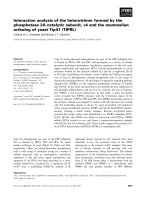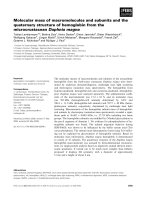Semantics chapter1 PG Semantics and the subject matter of semantics
Bạn đang xem bản rút gọn của tài liệu. Xem và tải ngay bản đầy đủ của tài liệu tại đây (2.23 MB, 55 trang )
Assoc. Prof. Dr. Ho Ngoc Trung
0913 30 64 84
Credits: 02
Coursebook: Understanding English
Semantics by Nguyen Hoa
Recommended reading: Lectures on
Discourse Analysis by Ho Ngoc Trung
Assessment:
- Mid-term test
- Assignment
- To help students understand deeply
about the meaning.
- To help students know about semantics
and the subject matter of semantics,
word meaning, dimensions of word
meaning, sense relations, sentence
meaning and utterance meaning
- To enable students to know how to use
words correctly according to different
contexts.
Students have to
take part in all the lessons
prepare the lessons carefully and finish
all home assignments
make presentation
1. Abbot, B (1999). The formal approach to meaning: Formal semantics and its
recent developments. Journal of foreign languages, 119: 1, 2-20.
2. Austin, J. L (1962). How to Do Things with Words. Oxford: Clarendon Press.
3. Barcelona, A (ed.) (2000). Metaphor and Metonymy at the Crossroads: a
Cognitive Perspective. Mouton Berlin & New York.
4. Bloomfield, L (1930). Language. London: Allen and Unwin.
5. Brown, G and Yule, G (1983). Discourse Analysis. Cambridge: CPU.
6. Bruce, I (1998). The role of "sense" in Gottlob Frege's theory of meaning. An
essay. University of New England, NSW, Australia.
7. Bybee, J. (1985). Morphology. Amsterdam: Benjamins.
8. Carnap, R (1937). The logical syntax of language. New York: Harcourt Brace.
9. Carnap, R (1942). Introduction to semantics. Cambridge, MA: MIT Press.
10. Carnap, R (1956). Meaning and necessity, 2nd edn. Chicago: Chicago
university Press.
11. Chomsky, N (2000). New horizona in the study of language and mind.
Cambridge: CUP.
12. Delahunty, G. P & Garvey, J. J (1994). Language, grammar, communication.
New York: Mc Graw-Hill, Inc.
13. Fauconnier, M (1985). Mental spaces: aspects of meaning contraction in
natural language. Cambridge, Mass-London: MIT Press.
14. Frawley, Charles C (1992). Linguistic semantics. Hillsdale, NJ: Laurence Erbaum
Associates.
15. Goddard, C (1998). Semantic analysis. New York: OUP.
Semantics and the
subject matter of
semantics
Semantics is generally defined as the
study of meaning in language (Lyons,
1977: 1; Hurford, Heasley, 1983: 1)
Saeed (2003: 3): “Semantics is the study
of the meaning of words and sentences”.
Units of language:
phonemes (phonology)
morphemes (morphology)
words
Phrases (syntax)
semantics
Sentences / utterances (syntax)
Discourse
Three main approaches in semantics study:
Lexical semantics: deals mainly with word
meaning and relations between them (e.g.
word structure, differences and similarities in
lexical semantic structure between different
languages, the relationship of word meaning to
sentence meaning and syntax)
Formal/logical semantics: is concerned with
relations between expressions, especially
sentences which express propositions. It
considers proposition as the meaning of the
sentence
and
is
concerned
with
the
truth conditions.
-
-
+
+
+
+
+
+
Cognitive semantics: meanings of expressions
are mental.
The main points of cognitive semantics:
Meaning is conceptualisation in a cognitive
model.
Semantic models are mainly perceptually
determined.
Semantic elements are based on spatial or
topological objects.
Cognitive models are primarily imageschematic.
Semantics is primary to syntax and partly
determines it.
Concept shows prototype effects.
•
Cognitive
semantics
is
concerned
with
perspective, imagery, construal, figure-ground
organization,
abstraction,
prototype,
conceptual metaphor, experiential gestalt,
idealized model.
•
conceptual metaphor: not a figure of speech,
but a way of imposing our understanding of
one sort of thing into another.
a snake in the grass / Kẻ thù giấu mặt
Time is money / Thời gian là vàng
Syntax studies the structure of wellformed phrases and sentences
Semantics deals with the way syntactic
structures are interpreted.
Word order (syntax) and meaning:
John kissed Mary.
Mary kissed John.
Semantics
studies
meaning
in
a
systematic way. It studies how language
organizes and expresses meaning.
Within the scope of the subject, we will
look at word meaning, sentence
meaning and utterance meaning.
“…that shows that there are three hundred and sixty-four days
when you might get un-birthday presents.”
“Certainly,” said Alice.
“And only one for birthday presents, you know. There’s glory for
you!”
“I don’t know what you mean by ‘glory,’” Alice said.
Humpty Dumpty smiled contemptuously. “Of course you don’t - till I
tell you. I meant ‘there’s a nice knockdown argument for you.’”
“But ‘glory’ doesn’t mean ‘a nice knockdown argument,” Alice
objected.
“When I use a word,” Humpty Dumpty said in a rather scornful
tone, “it means just what I choose it to mean – neither more nor
less.”
“The question is,” said Alice, “whether you can make words mean
so many different things.”
“the question is,” said Humpty Dumpty, “which is to be master –
that’s all.”
Meaning: semantics and pragmatics
Semantics (literal, outside context): words and
sentences
Pragmatics: (nonliteral, within context): linguistic
context and situation context
1.
A: Nice day
B: Yes, a bit warmer than yesterday, isn’t it
2.
Husband: when I go away next week, I’m taking
the car.
Wife: Oh. Are you? I need the car here to take the
kids to school
Husband: Nice day.
It’s cold.
Meaning is the convergence of three points:
language, mind and world.
The mind-world: studies such things as
perception, action, the mind’s bodily
constitution and intentionality
The mind-language: says that using and
understanding language is a mental
activity, and this activity is what
meaningful language exists for.
The
language-world:
maintains
that
language is the medium by which we
describe and explain reality.
The key to meaning is the notion of truthcondition. (correct use)
(i)
(ii)
(iii)
(iv)
(v)
(vi)
(vii)
An intrinsic property
The other words annexed to a word in a
dictionary
The connotation of a word
The place of anything in a system
That to which the user of a symbol actually
refers
That to which the user of a symbol believes
himself to be referring
That to which the interpreter of a symbol
(a)
(b)
(c)
refers
believes himself to be referring
believes the user to be referring
Smith means well/ Mary means business
That skull-and-cross bones means
danger.
Smoke means fire.
She didn’t really mean what she said.
The referential (or denotational
theory)
The ideational, or mentalist,
theory
The behaviourist theory
The meaning-in-use theory
The verificationist theory
The truth-conditions theory
The
referential
(or
denotational
theory): the meaning of an expression
is what it refers to, denotes, or stands
for
Note: For some words there are simply
no referents: all functional words: a,
the…
Some expressions point to non-existent
or fictional referents: elves, gnomes…
- The idea, held by some, that
things out there in the world do
not have an inherent structure
and that any structure we
perceive is just that: perceived









